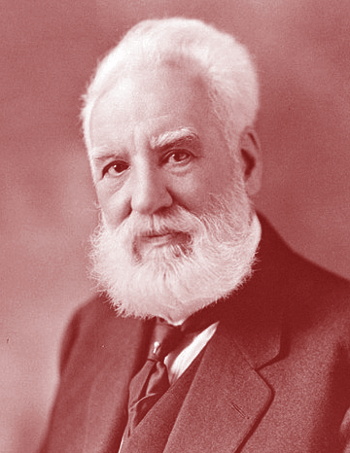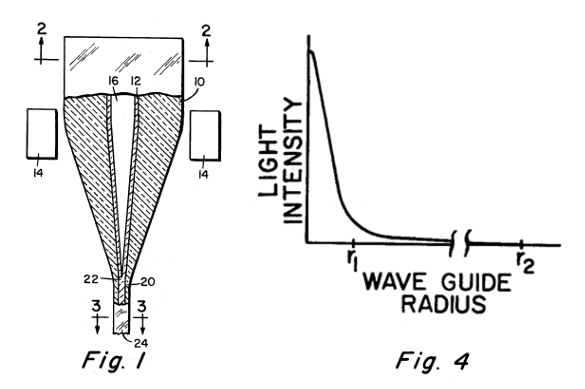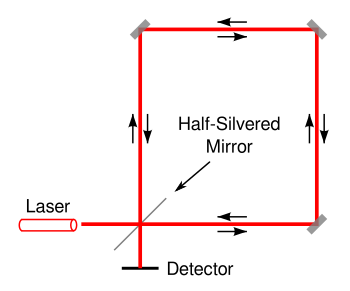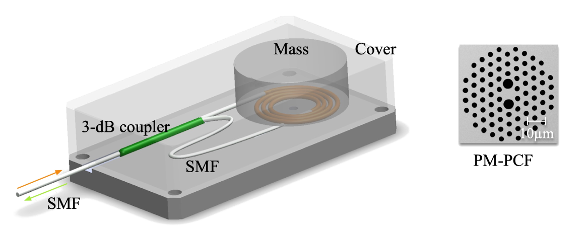Fiber-Optic Sensors
September 2, 2019
Soldiers in
antiquity likely
signaled to each other using
sunlight reflected from their
metal shields, and soldiers closer to our time used signaling
mirrors called
heliographs for the same purpose.
Optical communications technology became considerably advanced in 1880 when
telephone inventor,
Alexander Graham Bell (1847-1922), and his associate,
Charles Sumner Tainter (1854-1940), demonstrated their
photophone by
transmitting speech on a
light beam a distance of about 700
feet (213
meters) between building in
Washington, DC. Bell considered this
invention,
U.S. Patent No. 235,199,[1] to be more important than his invention of the telephone. Four of Bell's 18 patents were for his photophone.

Alexander Graham Bell in a Moffett Studio portrait circa 1914-1919.
Bell is best known as the inventor of the telephone, although others claimed the same invention.
Since Bell and other inventors of his time did not have electronic amplification devices even as primitive as the vacuum tube, they needed to be inventive indeed.
Bell's first idea, before vibrating diaphragms, was to use an array of vibrating metal reeds like the construction of an harmonica. The reeds would be excited at their specific resonant frequencies to switch currents that would excite identical reeds on the other end of a circuit.
(Wikimedia Commons image, via the Library and Archives Canada (image C-01733), modified for artistic effect)
The photophone's technology is now called
free-space optical communication, which is the optical equivalent of shouting across an
open field. You might have an example of this in your own home in the form or a
Television remote control (some remotes, as the one for the
Amazon Fire TV Stick, use
low power Bluetooth, but they may also have an
infrared option for
television control). Improvements in
laser,
optical detector technology, and
digital error-correction, make free-space an effective means to bridge small distances in
data networks. Applications for this include building-to-building hops on
college and
business campuses, and in
cities, as well as bridging
roads and
waterways. As you might imagine,
fog is a problem for free-space, so links are limited to still respectable distances of less than a
kilometer.
Light will also travel in a
transparent medium. In the early
19th century,
physicists,
Jean-Daniel Colladon (1802-1893) and
Jacques Babinet (1794-1872), created
fountain displays in which light was directed through jets of
water. Bundles of
glass fibers or
plastic fibers were used for transmission of images in the
1950s, and in 1961, Elias Snitzer of
American Optical theorized that a fiber with an extremely small diameter, a
single mode optical fiber, would transmit just a single
waveguide mode, thereby eliminating
phase interference from other modes along long distances.[2]
At that point, the principal problem was optical
loss in long fibers. As you can imagine, the world would appear quite dark when viewed through a
living room window a
mile thick. The essential problem was
iron impurity in the glass, and this problem was solved by
Donald Keck and
Peter Schultz of
Corning Glass who used
chemical vapor deposition to create
preforms from which optical fibers were
drawn to make
fiber-optic cable.[3] Such low-loss cable, along with advanced laser sources and detectors, has enabled the worldwide
Internet that we enjoy today.

Figures from US Patent No. 3,711,262, "Method of producing optical waveguide fibers," by Donald Keck and Peter Schultz, January 16, 1973. (Via Google Patents).[3]
Optical fibers are useful not just for communications, but for
sensing as well. If you pull on an optical fiber, the path length of the light is changed, so a
strain sensor is easily made. If the fiber is wrapped around a
material with high
thermal expansion, a
temperature change will stretch the fiber and produce a
thermometer. Likewise, an optical fiber will detect
pressure when wrapped around a
pressure vessel that
elastically deforms with a pressure change. Fiber-optic
hydrophones can be built on these same principles.
One important application is the measurement of
extremely high voltage. Since the glass fibers are intrinsically
insulating, there's a safe isolation from the voltage source, and the voltage is sensed by the
Kerr effect, the change in the
refractive index in response to an applied electric field, in the fiber material. While the prior examples are sensors that utilize an
intrinsic property of the optical fiber, fibers can be combined with other elements to form sensors. Many years ago I worked on the combination of
magneto-optical garnet and optical fibers to create a variety of
magnetic sensors for
aerospace applications. These included simple switches and
wheel speed sensors.
Fiber-optics has several advantages when applied to aerospace systems, including
weight reduction and
robustness against
electromagnetic interference and
lightning strikes. Temperature-resistant fibers made from
sapphire can extract light from the hottest parts of a
gas turbine engine to allow a determination of interior engine temperature.
Birefringent materials allow
extrinsic sensing with optical fibers of many variables that facilitate
engine control.[4] Birefringence can be used for measurement of temperature, pressure, strain,
force,
torsion, and
vibration.
The most interesting fiber-optic sensor is the
fiber-optic gyroscope, the fiber version of a
ring laser gyroscope. In compliance with the
Sagnac effect, named after
French physicist,
Georges Sagnac (1869-1928), who designed this device in 1913 as a means of testing the
theory of special relativity,
counter-propagating light beams in a closed path will have a
phase shift as a consequence of
angular velocity. An
interferometer measures the shift to indicate the angular velocity.

Schematic diagram of a Sagnac interferometer, the principle behind the ring laser gyroscope (RLG) and the fiber-optic gyroscope. A ring laser gyroscope has an internal (typically helium-neon) laser source. A coil of multiple turns of optical fiber amplifies the effect in a smaller volume in the fiber-optic gyroscope.
There's a lot of materials science involved in the construction of a ring laser gyroscope, principally in the containment structure. The principal material for an RLG body is Zerodur®, a lithium-aluminosilicate glass-ceramic developed by Schott AG. Zerodur contains crystallites in a glass matrix, and this gives it a frosty appearance. It has an extremely low thermal expansion coefficient (less than 0.10 x 10−6/kelvin over a wide temperature range), so it's ideal for an RLG, where small changes in path length would produce errors.
(Modified Wikimedia Commons image by Krishnavedala.)
Recently, a team of
electrical engineers from the
Hong Kong Polytechnic University (Hong Kong, China) has developed fiber-optic sensors to continually monitor
accelerations and vibrations on
trains to detect vehicle or
track problems. These sensors utilize an optical fiber structured to produce birefringence in a Sagnac interferometer.[5-6] Their research is published in an
open access article in
Optics Express.[5]
Says
Zhengyong Liu, the lead
author of the
paper describing this work, “An all-optical sensing network has many advantages as it is immune to electromagnetic interference, has long transmission distance and the sensors don't require
electricity... However, there is a need for fiber-optic sensors that are optimized to measure different parameters in railway systems."[6]
The Hong Kong fiber-optic accelerometer is based on a
polarization-maintaining photonic crystal fiber that's formed into a disk shaped coil just 15 millimeters in diameter. This coiled fiber is glued onto a
stainless steel substrate, and a
cylindrical mass is affixed above it. Vibrations cause the mass to press the fiber, and this causes a phase shift in its transmitted light that's read by an interferometer (see figure).[5-6]

The Hong Kong Polytechnic University fiber-optic vibration sensor. The polarization-maintaining photonic crystal fiber (PM-PCF) is driven by a single-mode fiber (SMF). A cross-section of the photonic crystal structure is shown on the right. (Reformatted open access schematic diagram of the fiber-optic vibration sensor from The Hong Kong Polytechnic University.[5] Click for larger image.)
The Hong Kong team designed and fabricated the sensing fiber to have
air holes to provide the photonic crystal structure, and also to have a small diameter, low
bending loss, and high birefringence.[6] The resulting accelerometer sensor has double the response time of conventional fiber sensors that incorporate a
Bragg grating as the sensing structure.[6] The fiber-optic sensor has no moving parts, and it is immune to the
electrical noise that exists in the high-voltage train environment.[6]
Field tests were done on an in-service train in comparison with a Bragg grating fiber accelerometer and a
piezoelectric accelerometer.[6] The accelerometer sensor based on the polarization-maintaining photonic crystal fiber had a sensitivity of ~8 pm/
g, and a
resonant frequency exceeding 2.5
kHz.[5] The high frequency response allows detection of the
impulse associated with a defect or
crack present on the railway track.[5]
The Hong Kong researchers believe that their sensor could be combined with an
artificial intelligence system to prevent
catastrophic train
derailments and other accidents.[6]
Hwa-yaw Tam, the research
team leader remarks that "Each year, train accidents lead to severe
injuries and even
deaths... Our fiber accelerometers could be used for
real-time monitoring of defects in the railway track or the train to pinpoint problems before an accident occurs."[6] Zhengyong Liu adds that “In addition to railway monitoring, these new accelerometers can be utilized in other vibration monitoring applications, for example,
structural health monitoring for buildings and
bridges and vibration measurements of
aircraft wings."[6]
References:
- A.G. Bell, "Apparatus for Signalling and Communicating, called Photophone," U.S. Patent No. 235,199, December 7, 1880 (via Google Patents).
- Mary Bellis, "How Fiber Optics Was Invented," ThoughtCo. Website, June 30, 2019.
- D. Keck and P. Schultz, "Method of producing optical waveguide fibers," US Patent No. 3,711,262, January 16, 1973 (via Google Patents).
- Devlin M. Gualtieri, Janpu Hou, William R. Rapoport, and Herman van de Vaart, "Birefringent-biased sensor having temperature compensation, US Patent No. 5,694,205, December 2, 1997 (via Google Patents).
- Zhengyong Liu, Lin Htein, Dinusha Serandi Gunawardena, Weng-Hong Chung, Chao Lu, Kang-Kuen Lee, and Hwa-Yaw Tam, "Novel accelerometer realized by a polarization-maintaining photonic crystal fiber for railway monitoring applications," Optics Express, vol. 27, no. 15 (July 17, 2019), pp. 21597-21607, https://doi.org/10.1364/OE.27.021597. This is an open access article with a PDF file available at the same location.
- Fiber-optic Vibration Sensors Could Prevent Train Accidents, Optical Society of America Press Release, July 17, 2019.
Linked Keywords: Soldier; Ancient Greece; antiquity; signal; signaled; sunlight; reflection (physics); reflected; metal; shield; mirror; heliograph; Optical communication; technology; telephone; inventor; Alexander Graham Bell (1847-1922); Charles Sumner Tainter (1854-940); photophone; transmission (telecommunications); transmitting; speech; light beam; foot (length); feet; meter; Washington, DC; invention; U.S. Patent; portrait; Elisha Gray and Alexander Bell telephone controversy; electronic amplification device; vacuum tube; acoustics; vibration; diaphragm (acoustics); reed (mouthpiece); harmonica; resonance; resonant frequency; electric switch; electric current; electronic circuit; Wikimedia Commons; Library and Archives Canada; free-space optical communication; football pitch; open field; television remote control; Amazon Fire TV Stick; Bluetooth Low Energy; infrared; television; laser; photodetector; optical detector; error detection and correction; digital error-correction; data network; college; business; campus; city; road; waterway; fog; kilometer; transparency; transparent; 19th century; physicists; Jean-Daniel Colladon (1802-1893); Jacques Babinet (1794-1872); fountain; water; plastic optical fiber; 1950s; American Optical; single mode optical fiber; waveguide (optics; mode (electromagnetism); interferometry; phase interference; loss; living room; window; mile; iron; impurity; Donald Keck; Peter Schultz; Corning Inc.; Corning Glass; chemical vapor deposition; preform; drawing (manufacturing); drawn; fiber-optic cable; Internet; Google Patents; fiber optic sensor; deformation (mechanics); strain; material; thermal expansion; temperature; thermometer; pressure; pressure vessel; elasticity (physics); plasticity (physics); hydrophone; extremely high voltage; insulator (electricity); insulating; Kerr effect; refractive index; intrinsic property; magneto-optic effect; garnet; magnetic field; aerospace; wheel speed sensor; weight; resilience; robustness; electromagnetic interference; lightning strike; sapphire; gas turbine engine; birefringence; Birefringent material; extrinsic property; FADEC; engine control; force; torsion (mechanics); fiber-optic gyroscope; ring laser gyroscope; Sagnac effect; France; French; physicist; Georges Sagnac (1869-1928); theory of special relativity; wave propagation; counter-propagating; phase shift; angular velocity; schematic diagram; helium-neon; laser; volume; materials science; Zerodur®; lithium-aluminosilicate glass; ceramic; Schott AG; crystallite; thermal expansion coefficient; kelvin; Krishnavedala; electrical engineering; electrical engineer; Hong Kong Polytechnic University (Hong Kong, China); acceleration; train; track (rail transport); open-access journal; open access article; Optics Express; Zhengyong Liu; author; scientific journal; paper; electricity; polarization (waves); polarization-maintaining; photonic crystal; stainless steel; substrate (materials science); cylinder (geometry); cylindrical; mass; cross-section; air; hole; bend radius (fiber optics); bending loss; fiber Bragg grating; electrical noise; piezoelectricity; piezoelectric; gravitational acceleration; hertz; kHz; impulse (physics); fracture; crack; artificial intelligence; catastrophic failure; derailment; Hwa-yaw Tam; team leader; injury; death; real-time data; real-time monitoring; structural health monitoring; bridge; aircraft wing.